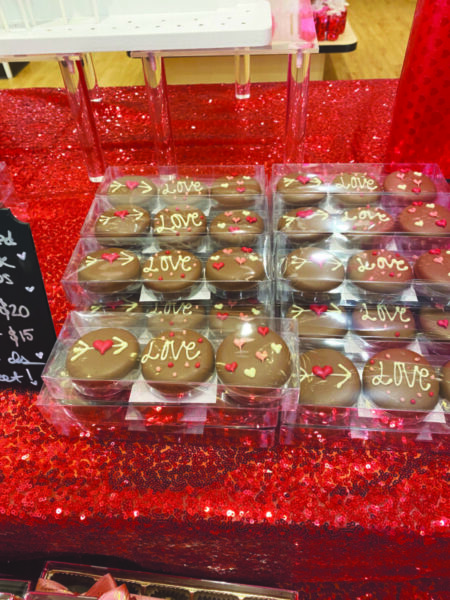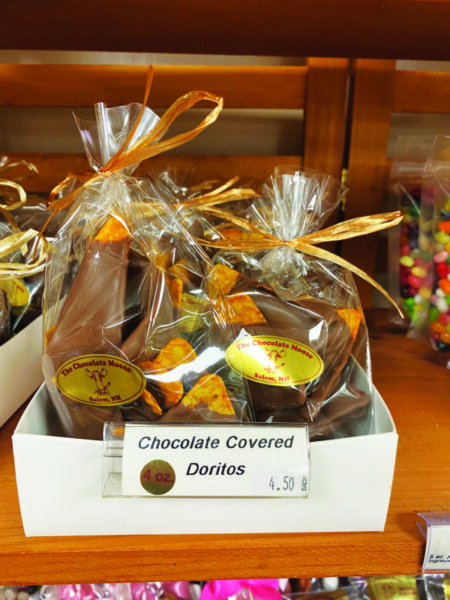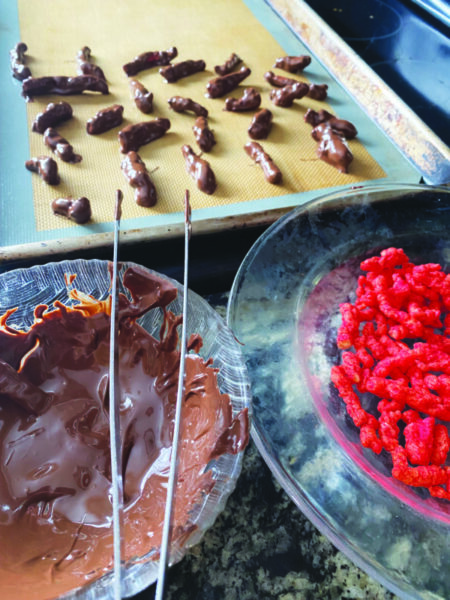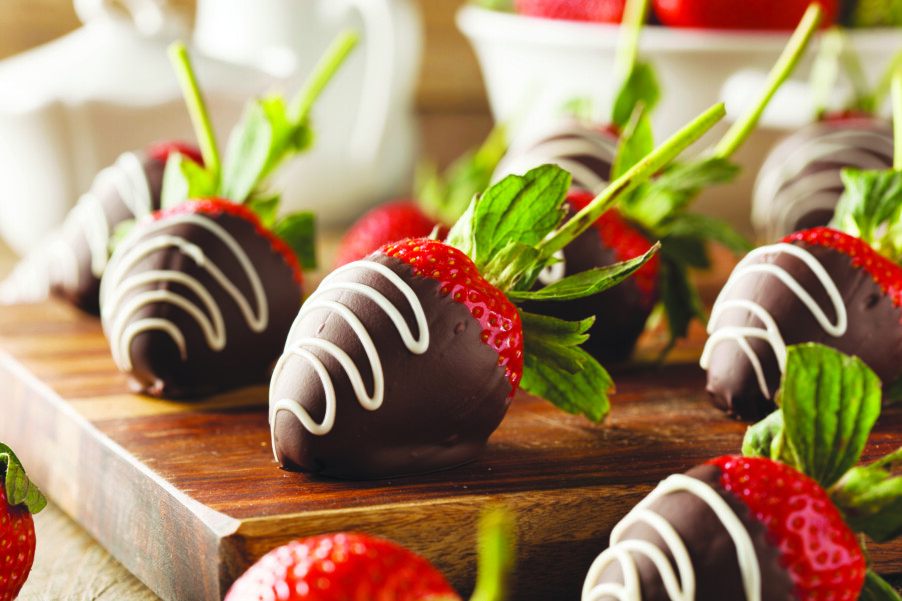Make tasty things tastier with a chocolate coating
By John Fladd
jfladd@hippopress.com
There is something you need to understand about chocolate-covered strawberries.
They are ephemeral. They need to be eaten immediately.
They are also very romantic, so it’s tempting to hold on to them, and savor the gesture, but Paige Quish says don’t do it. Quish is the manager of Van Otis Chocolates in Manchester, and she knows and understands chocolate-covered strawberries on a bone-deep, almost spiritual level.
Van Otis goes through a lot of strawberries around Valentine’s Day. “Hundreds of pounds of strawberries,” Quish said. “Hundreds. Of. Pounds. Every pound is about nine to 12 berries, so I mean we’re talking a lot of strawberries.”
She said the clock starts ticking as soon as a berry is coated with chocolate.
“Freshness is definitely really important,” she said. “Chocolate-covered strawberries are best enjoyed within 24 hours. Some people don’t know that, but chocolate is dry, believe it or not — there’s no water involved with it — and then once it touches any kind of strawberry or fruit that has a watery base with a lot of moisture to it, the shelf life immediately starts to expire on it.” That’s why a two-day-old chocolate strawberry in your refrigerator might start looking sad and tired, she said. The fruit dries quickly in contact with the chocolate, and shrinks, so its chocolate coat doesn’t fit it anymore and it looks dejected.
There are many chocolate-giving holidays throughout the year, Quish said, but Valentine’s Day is one of the biggest.
“We do a lot of molding for our Christmas season and Easter,” she said, “you know, the bunnies and all that. But dipped fruit specifically? I’d say that strawberries are definitely the top seller for Valentine’s.”
A large portion of everything Van Otis makes is covered with chocolate.

“We cover almost everything in chocolate,” Quish said. “Anything that you see that has the chocolate coating on it goes through our enrobing system. All of our creams, our jellies — anything that you see like that — our liquor cordials, those are all fully enrobed. Orange peels and dipped cherries, just about everything.” All the chocolate enrobing is done on-site, she said. “A lot of people refer to it like the I Love Lucy episode, when they’re putting stuff on [the conveyer belt], but it’s basically a chocolate waterfall. There’s one part of the machine that coats the bottom of everything, and then there’s the top part that gets fully drenched and enrobed, and then it goes through the drying tunnel.”
One trend that began several years ago and is still gaining momentum, Quish said, is covering something salty with chocolate, for a salty/sweet contrast.
Chocolate-covered pretzels and potato chips have become increasingly popular.
“We try to think outside the box of things that would be delicious in chocolate,” she said. Chocolate-covered bacon has become a go-to gift for men. “Super Bowl, Father’s Day — those things are usually really popular for the chocolate-covered bacon.”
A good rule of thumb, she said, is that if something is delicious on its own, it will probably be even better coated in chocolate. “We have our Oreos. We take those and we’ll enrobe them, and animal crackers are something new that we started last year. We have gummy worms and gummy bears [that we cover with chocolate].”
Surprisingly, Quish said, chewy gummy candies actually hold onto a chocolate coating pretty well. It seems as if it would crumble and fall off while it’s being eaten, but she said that’s not the case.
“As soon as that chocolate dries and sets, it’s on there,” she said. “It’s fully coated. And it’s so good! We have people who say they’ve tried chocolate-covered gummy bears elsewhere and they’re obsessed with ours. They always say that it doesn’t compare. We have a really skilled production team so they definitely have their magic that they apply to all the goodies. Swedish Fish is another one of them.”
Jeffrey Bart’s family has owned and run the Granite State Candy Shoppes, which has shops in Concord and Manchester, for almost 100 years. He said the most popular candy his stores sell is also one of the simplest.
“Our most popular item that we make and sell are dark chocolate nonpareils,” he said. “Some people might call them snow caps; it’s a small round of chocolate with white nonpareil seeds on them.” But after that, he said, customers will go for anything coated in chocolate.
“Peanut butter cups,” Bart said. “We make a lot of peanut butter cups. And our third is our butter crunch — a toffee dipped in chocolate and then sprinkled with roasted chopped nuts, almonds. They are very, very popular. We make those constantly, all the time.”
He said that his staff too, struggles to keep up with the demand for chocolate-covered strawberries at this time of the year.
“People still come to us and they want to buy a traditional heart-shaped box with assorted chocolates, but we advise ordering strawberries in advance if at all possible. We make them available on the 13th and the 14th, only. We [make] a huge variety of different berries. We make straight-dipped [berries] in dark, milk, and white chocolate. And then we have a huge array of what we call “Fancy Dipped Berries”; they’re dipped in chocolate, and then we’ll roll them in decoratifs, and then we’ll hand decorate them with chocolate drizzle and do another large assortment of other types of fancy decorations for the berries, too.”
Bart, too, advises customers not to wait too long to consume the berries.
“It’s best if you can consume them within 24 hours,” he said. “If you’re going to keep them for a little bit, we recommend refrigerating them, but when you want to enjoy them we recommend taking them out and letting them sit on the counter or sit out for a short period of time — 20 minutes, a half an hour, maybe an hour — so they warm up a little bit, and they’ll taste better that way.”
Another classic and popular item at Granite State Candy are chocolate-covered cherries.
“We use cordial cherries,” Bart said. “It’s a whole cherry with a liquid center. We have those available in milk and dark chocolate.” But some of the treats are less traditional. “We sell a lot of chocolate-dipped Twinkies,” he said. “That’s a fun, crazy little item that we do that is very popular. We’ve been doing it for a number of years now, so that’s a great item. We also coat orange peel, ginger — candied ginger — in chocolate, and that’s very popular. And another unique … item is something called the Jordan Cracker. It’s an oblong-shaped baked, sugarless cracker that we coat in chocolate and people love them.”
Jim Pasquill is the store manager for Sweetz & More in the Mall of New Hampshire in Manchester. He says there is a strong, consistent demand for any type of gummy candy covered in chocolate.
“Anything like Haribo gummy bears, even something like Juju cinnamon bears, we have those covered in chocolate,” he said. “The chocolate-covered cinnamon bears don’t always sell as well. I think it might be because the mixture of chocolate and cinnamon isn’t a favorite mix. However, we pretty much have the same brands on our theater box wall. It’s called Money Bears. It’s the same thing. It’s just packaged differently and it’s cheaper. And that also tends to be as hot as the chocolate-covered gummy bears on our pouch wall. It’s the same thing. Customers keep on coming in here asking us if we have them. Unfortunately, we don’t because they sell too fast.”
Pasquill said it is hard to keep this type of candy in stock.
“We try to get at least get 16 to 24 pouches in at a time,” he said, “because that can usually only last us a couple days — maybe a week. It’s a steady pace on the milk chocolate covered gummy bears but we do try and make sure we have a large quantity on our shelves.” He said he tries to keep just enough in stock, so that there is a constant turnover and the candy stays fresh.
Pasquill himself doesn’t necessarily go for outrageous combinations of chocolate and candies. “Me, I’m like a traditional guy,” he said. “I like nuts — cashews, almonds, peanuts — something with a solid crunch. I’m not really for the crazy Swedish fish, the gummy bears, but I can see why it sells. Now, I won’t necessarily say that they are healthy, but we do have chocolate-covered raisins, and we do have chocolate-covered cranberries. That can be somewhat healthy because we do have dark chocolate, and I know dark chocolate is more healthy than milk.”

In Salem, a lot of The Chocolate Moose’s customers would agree with Pasquill’s preference for chocolate-covered nuts. According to owner Nancy Cornell, “what we have to make every day is the turtles.” She pointed to a long display case filled with different varieties of turtles, in all sizes, and with all different types of nuts. “This whole line all the way down is all turtles. We have mini turtles, in milk and dark chocolate, pecans and cashews, and then the larger ones, the same thing, and then there’s almonds, macadamia, and then there are Oreo turtles. The Oreo turtles have no nuts in them.”
Chocolate-covered candy apples are another big seller for Cornell.
“Today,” she said, “we’ve been selling apples. It’s mid-morning and we’ve only got one left. But at Christmas we usually start at 2:30 in the morning making the candy apples. Even now, my husband is up at 3 o’clock at night and he does apples galore. Another thing that’s popular is our peanut butter cups. People come from Boston and so on to come up and get our peanut butter cups.”
Cornell said fruit works really well dipped in chocolate. “This” she said, pointing, “is candied orange peel, and I have grapefruit peels too, but we’re sold out of them right now. To get that bitter taste away, you have to boil them three or four times, then dry them out for days, with sugar. And then we dip them. Same with the ginger. Ginger is hot, so when you put it in chocolate it doesn’t quite have that hotness to it. Orange peels, we mostly cover in dark [chocolate]; that seems to be what most people want. And we have dried apricots, too.”
She said that an old-fashioned favorite has been coming back into fashion recently. “Marzipan went through a period of time where people didn’t want it,” Cornell said, “and I would have it, and then I’d have to throw it away. But now it’s back again. People go in cycles, and they actually ask for it now.”
Some things never go out of style, though. “Oreos dipped in chocolate and graham crackers dipped are big,” she said. “They’ve been that way for years.I don’t think that’s ever going to change.”
DIY a chocolate coating
Buying chocolate-covered delicious things is an excellent way to express your affection, but there is always the homemade approach. Coating snacks in chocolate yourself (a) might impress the type of person that is impressed by this sort of thing, and (b) allows for a level of customization.
Making a chocolate-covered snack isn’t complicated — at least in theory. You only need two ingredients: a snack and some chocolate. It’s the details that can get a little finicky, such as what type of chocolate you use.
Richard Tango-Lowy is a master chocolatier and the owner of Dancing Lion Chocolate in Manchester. He said it’s not enough that a chocolate is delicious; if you’re going to coat something with it, you need to read the label.
“There are a lot of chocolates,” he said, “especially chocolate chips, that have ingredients that don’t lend themselves to [coating things]. You’re looking for three ingredients: cocoa solids, cocoa butter and sugar. Plus milk powder if it’s a milk chocolate.”
He said to stay away from anything labeled as “chocolate-style baking chips.”
Laura Wither, the chocolate maker for Loon Chocolate in Manchester, agrees. “There are additives in many [chocolates] that might or might not help you coat things — palm oil, and coconut oil, and things like that,” she said. She pointed out that Loon Chocolate doesn’t use them.
She also pointed out that it helps to be thoughtful about what kind of snack you’re covering with chocolate.
“I would say that you want to look for complementary flavors,” she said. “For example, we have a chocolate that leans towards the fruity side and I love it with pineapple. Contrasting can also be good. A lot of it is just taste testing, which is the fun part of the job here.”
If you want to coat a piece of fruit with chocolate, she said, it has to be patted as dry as possible.
“Chocolate and water are generally not good friends,” she said. “There are some exceptions but for the most part if we were covering fruit it would be dried fruit. I know people do chocolate-dipped strawberries, but generally when you do that, a lot of times, you’re using a coating chocolate.”
One fiddly part of melting chocolate at home is something called tempering. This is a process to make a chocolate shiny and give it a good snap when you break it or bite into it. It doesn’t change the flavor of a chocolate; it is a way of aligning the crystal structure of a batch of chocolate to bring out its best characteristics. On baking competition shows, judges will call out a contestant about how well or poorly tempered their chocolate is.
The accepted procedure that many home confectioners use to temper their chocolate involves manipulating its temperature:
Step 1 – Heat the chocolate in a double boiler, or in your microwave a few seconds at a time, until it reaches a temperature of 115°F.
Step 2 – Remove it from heat, and stir it until the temperature drops to 81°F. Most home chocolate-temperers will hurry the process by stirring unmelted chocolate into it. (I’ve used frozen chocolate to do this and have been reasonably pleased with the results.)
Step 3 – Raise the temperature of the chocolate again, to 92°F.
Step 4 – Start dipping.
If you think this seems like a difficult way to spend a morning, Richard Tango-Lowy agrees with you.
“You’re not going to do it at home unless you know what you’re doing,” he said. “Tempering is just one of those things that’s inherently complicated. You’ll never learn how to temper by watching videos. Most of them are just dead wrong.” To learn to temper chocolate at a professional level, he said, takes years of practice, and specialized techniques. Fortunately, there is a work-around, he said.
“If you don’t know how to temper, use chocolate that you like, one that is already tempered. Melt it extremely gently in the microwave — just mostly melt it, you’ll end up with a reasonably passable temper to put on your strawberries and things.” He advised melting the chocolate, a little at a time, until only a third or so of the chocolate remains solid, then to stir it until the chunks melt away.

Once you have your chocolate melted, and delicious snack food standing by, it’s time to start covering things with chocolate. You can use chopsticks, tweezers or a fork to dip your snack and roll it around to cover it, or use a spoon to gently blanket it with melted chocolate. Coat the snacks, and put them on a piece of parchment paper or a silicone mat to cool and harden. In the photo below, I have coated Flamin’ Hot Cheetos with a 53 percent dark chocolate. I learned the hard way that they are delicious coated in white chocolate but can’t be swished around in it. The white chocolate will turn pink and look like peppermint, which it emphatically is not. I had the best luck laying each Cheeto on the surface of the melted white chocolate, then spooning it over the Cheeto. — John Fladdk trails.
Things to cover with chocolate
Easily made and stored for a week or so:
Pretzels — especially peanut butter-filled ones
Crystalized ginger
Dried blueberries, spooned into clusters
Candied orange slices
Banana chips
Any nuts — perhaps something unusual, like pistachios or shelled sunflower seeds
Other candies like licorice bites or gummies
Corn chips
Spicy snacks — Flamin’ Hot Cheetos work very well
Cookies — especially store-bought crunchy ones like Oreos or Vienna fingers
Animal crackers
Marzipan
Espresso beans, especially dusted with lemon or lime zest
Easily made but must be eaten immediately:
Strawberries
Mango cubes
Fresh mint leaves
Avocado slices
Jalapeno slices
Cream cheese and lemon zest, or goat cheese
Featured Image: Courtesy photo.





